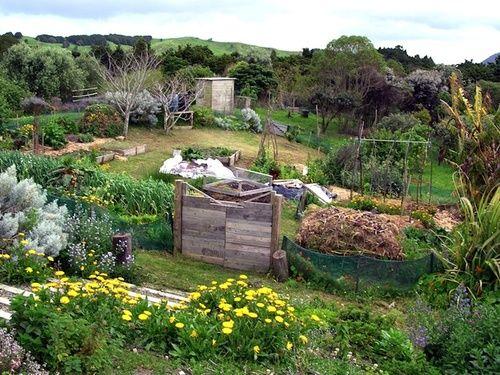La permaculture, a term coined by Bill Mollison and David Holmgren in the mid-XNUMXs, indicates a design method and management eco friendly both urban and agricultural living spaces. Let's find out better.
> Guiding principles
> The area
> How to become a permacultor

The origins of permaculture
The term permaculture was coined by Bill Mollison and David Holmgren in the mid-XNUMXs to describe a integrated eco-sustainable design and management system human settlements and the environment.
The word itself has two contemporary roots being a crasis between the English terms permanent culture and permanent agriculture: meaning that a permanent "culture" needs permanent agriculture at the base. As Bill Mollison said: "A culture cannot survive long without a sustainable agricultural base and a land use ethic."
Thus we speak of culture rather than just agriculture precisely because the disciplines concerned and involved there are many such as: botany, geology, physics, chemistry, zoology, medicine, physiology, forestry, architecture, biology, landscape ecology, food, ethical investments, sociology and methods of cooperation, renewable energy, pedagogy, etc. All are in mutual integration and aimed at developing a unique model in permaculture.
They exist at the basis of permaculture 3 ethical principles:
- care for the earth
- caring for people
- establish limits on consumption and reproduction, and redistribution of surplus
Permaculture is a way of approaching, thinking and intervening in the environment according to an eco-sustainable and integrated philosophy. It is usually applied for the design of human and productive settlements, although it can be applied in other socio-cultural areas.
The 12 Guiding Principles of Permaculture
- Observe and interact: beauty is in the eye of the beholder
- Collect and store energy: prepare the hay while the sun shines
- Secure a crop: you cannot work on an empty stomach
- Apply self-regulation and accept feedback: the sins of the fathers fall on the children up to the seventh generation
- Use and enhance renewable resources and services: let nature take its course
- Do not produce waste: a timed point saves a hundred
- Design from retail model: trees are not the forest
- Integrate instead of separate: many hands make the work light
- Small and slow is beautiful: the bigger they are, the more they make noise when falling, those who go slowly go healthy and go far
- Use and value diversity: do not put all the eggs in one basket
- Use and enhance the margin: stop thinking that you are on the right track just because it is very busy
- React to changes and use them creatively: you have to learn to see things not only as they are but also as they will be
Gardening also has a therapeutic action: find out how

The areas
One of the specific concepts in permaculture design is that of zones. With permaculture zones we mean concentric spaces that develop from the central area (the man-house), continuing outwards and differentiating from each other according to the frequency of use by man. Observing the presence of ecological, economic and cultural flows and forces, the greatest presence and intensity will be in the busiest area and decreasing towards the external areas.
Generally beyond the central area of the house, called 0 zone we find;
Zone 1, that it consists of the neighboring space, very popular and cared for, where, for example, the hens with their chicks, the spiral of aromatic herbs and the vegetables of daily use are kept under an eye.
Zone 2 instead it includes the vegetable garden proper, the orchard, the animal shelters and all the areas visited approximately once a day.
In zone 3 we find the cultivated fields, the meadows, the vineyards, the olive groves and the pastures where the animals roam freely.
Zone 4 it is semi-wild, frequented only for the collection of fruits and wild herbs, for hunting and for the gathering of mushrooms and wood.
In zone 5 we find the area left to work undisturbed nature where man also acts as a guest and where he goes to observe and learn the secrets of Mother Nature.
Design criteria
Permaculture design criteria find their foundation inobservation of natural models and through their imitationee reproduction, man inserts himself into the environment with integrated and ethically productive methods.
During the design it is well remembered that every single element has multiple interactions and functions and therefore, before intervening, the possible developments of a change in status must be observed, known and hypothesized.
Biodiversity is one of the values that is increased as much as possible; this allows to expand and develop as many synergies as possible between the animate and inanimate elements of the ecosystem.
Biological and energy resources they are key points to analyze, observe and know in great detail, before starting the design, in order to preserve the energies in the system and make them circulate by keeping them for a maximum time within the cycle.
Some of natural patterns and guidelines for the design are enclosed in these statements:
- everything influences everything
- start from your door
- work where it is most effective
- works "with" and not "against"
- global vision, local action
- the limit is in your imagination
- the problem is the solution
- cooperation and not competition
- and… if there is no joy, the project is wrong!
Becoming a permaculturist
There are certified and internationally recognized courses lasting 72 hours, in which all the topics that make up permaculture are addressed both in theory and in practice. There is also a specific path of over two years to subsequently be able to teach permaculture.
READ MORE
Interview with Massimo Giudetti, supporter of permaculture and the synergistic vegetable garden
Other articles on permaculture:
> Permaculture, transition and deep ecology
> The link between theater and permaculture
> The 12 principles of permaculture
> Food forest, the edible forest, an alternative to the vegetable garden
> Degrowth, myth or possible reality?
> The CasciNet project in Milan
| Homesteadlady.com


























